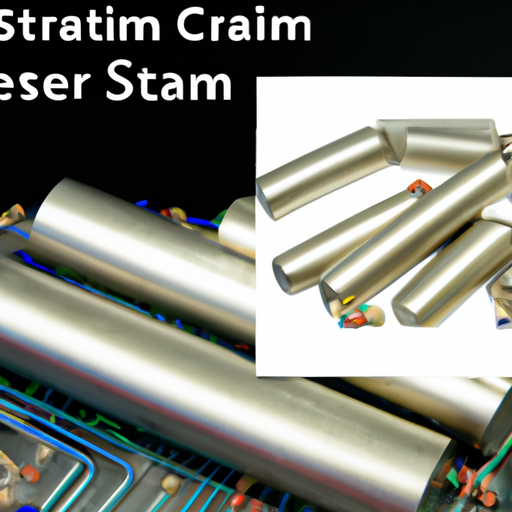Capacitors are essential components in electronic devices, used to store and release electrical energy. They come in various shapes and sizes, and are used in a wide range of applications, from simple circuits to complex electronic systems. The production process for capacitors is a precise and intricate one, involving several steps to ensure the final product meets the required specifications and quality standards.

1. Material selection: The first step in the production process is the selection of materials. Capacitors are made up of two conductive plates separated by a dielectric material. The conductive plates are usually made of metal, such as aluminum or tantalum, while the dielectric material can be made of ceramic, plastic, or paper. The choice of materials depends on the specific requirements of the capacitor, such as capacitance, voltage rating, and temperature stability.
2. Electrode preparation: The conductive plates, or electrodes, are prepared by cutting them into the desired shape and size. The electrodes are then cleaned and treated to remove any impurities or contaminants that could affect the performance of the capacitor.
3. Dielectric preparation: The dielectric material is also prepared by cutting it into the required shape and size. The dielectric material is then coated with a thin layer of conductive material, such as silver or graphite, to improve its conductivity and ensure a good connection with the electrodes.
4. Assembly: The next step in the production process is the assembly of the capacitor. The electrodes and dielectric material are stacked together in layers, with the electrodes sandwiched between the dielectric material. The layers are then rolled or folded into the desired shape, such as a cylindrical or rectangular form.
5. Impregnation: In some cases, the capacitor is impregnated with a liquid or gel electrolyte to improve its performance and reliability. The electrolyte helps to enhance the conductivity of the capacitor and reduce the internal resistance, allowing for faster charging and discharging.
6. Encapsulation: Once the capacitor is assembled and impregnated, it is encapsulated in a protective casing to shield it from external elements, such as moisture, dust, and temperature fluctuations. The casing is typically made of plastic or metal, and is designed to be durable and resistant to damage.
7. Testing: The final step in the production process is testing the capacitor to ensure it meets the required specifications and quality standards. The capacitor is subjected to various tests, such as capacitance, voltage, and temperature tests, to verify its performance and reliability. Any capacitors that fail to meet the required standards are rejected and discarded.
Overall, the production process for capacitors is a complex and precise one, involving several steps to ensure the final product meets the required specifications and quality standards. By carefully selecting materials, preparing electrodes and dielectric materials, assembling the capacitor, impregnating it with electrolyte, encapsulating it in a protective casing, and testing it for performance and reliability, manufacturers can produce high-quality capacitors that are essential components in electronic devices.
Capacitors are essential components in electronic devices, used to store and release electrical energy. They come in various shapes and sizes, and are used in a wide range of applications, from simple circuits to complex electronic systems. The production process for capacitors is a precise and intricate one, involving several steps to ensure the final product meets the required specifications and quality standards.

1. Material selection: The first step in the production process is the selection of materials. Capacitors are made up of two conductive plates separated by a dielectric material. The conductive plates are usually made of metal, such as aluminum or tantalum, while the dielectric material can be made of ceramic, plastic, or paper. The choice of materials depends on the specific requirements of the capacitor, such as capacitance, voltage rating, and temperature stability.
2. Electrode preparation: The conductive plates, or electrodes, are prepared by cutting them into the desired shape and size. The electrodes are then cleaned and treated to remove any impurities or contaminants that could affect the performance of the capacitor.
3. Dielectric preparation: The dielectric material is also prepared by cutting it into the required shape and size. The dielectric material is then coated with a thin layer of conductive material, such as silver or graphite, to improve its conductivity and ensure a good connection with the electrodes.
4. Assembly: The next step in the production process is the assembly of the capacitor. The electrodes and dielectric material are stacked together in layers, with the electrodes sandwiched between the dielectric material. The layers are then rolled or folded into the desired shape, such as a cylindrical or rectangular form.
5. Impregnation: In some cases, the capacitor is impregnated with a liquid or gel electrolyte to improve its performance and reliability. The electrolyte helps to enhance the conductivity of the capacitor and reduce the internal resistance, allowing for faster charging and discharging.
6. Encapsulation: Once the capacitor is assembled and impregnated, it is encapsulated in a protective casing to shield it from external elements, such as moisture, dust, and temperature fluctuations. The casing is typically made of plastic or metal, and is designed to be durable and resistant to damage.
7. Testing: The final step in the production process is testing the capacitor to ensure it meets the required specifications and quality standards. The capacitor is subjected to various tests, such as capacitance, voltage, and temperature tests, to verify its performance and reliability. Any capacitors that fail to meet the required standards are rejected and discarded.
Overall, the production process for capacitors is a complex and precise one, involving several steps to ensure the final product meets the required specifications and quality standards. By carefully selecting materials, preparing electrodes and dielectric materials, assembling the capacitor, impregnating it with electrolyte, encapsulating it in a protective casing, and testing it for performance and reliability, manufacturers can produce high-quality capacitors that are essential components in electronic devices.